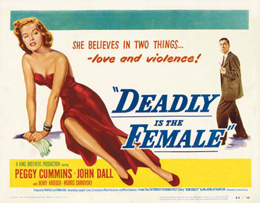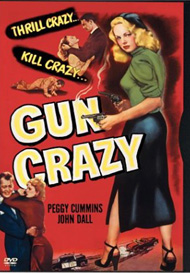| Release List | Reviews | Price Search | Shop | Newsletter | Forum | DVD Giveaways | Blu-Ray/ HD DVD | Advertise |
| Reviews & Columns |
|
Reviews DVD TV on DVD Blu-ray International DVDs Theatrical Reviews by Studio Video Games Features Collector Series DVDs Easter Egg Database Interviews DVD Talk TV DVD Talk Radio Feature Articles Columns Anime Talk DVD Savant HD Talk Horror DVDs Silent DVD
|
DVD Talk Forum |
|
|
| Resources |
|
DVD Price Search Customer Service #'s RCE Info Links |
|
Columns
|
 |
Gun Crazy
|
||||
L'Amour fou got a shot in the arm with Joseph H. Lewis' Gun Crazy. It's one of the most popular films noir because, like Kiss Me Deadly, it's just so much fun. This tale of Romeo and Juliet as armed robbers flaunted Hollywood taboos both written and unwritten and came with a tawdry appeal that begins with the anatomically exaggerated poster illustration (the DVD cover, above). Guns play an important role but they're not fetishized; the fatalistic game of our two lover-criminals is taken to delirious extremes. Noted for a realistic, riveting robbery sequence shot all in one take, Gun Crazy is for the most part a highly stylized show.
Gun Crazy is a cinematic sketch book of good techniques used with perfect precision. Director Joseph H. Lewis worked with a motivated crew on this low-budget independent picture and it made his reputation as an extremely creative moviemaker. Shots are splendidly designed down to the last detail. When Lewis frames young Rusty Tamblyn half off-screen to accentuate his instability, or places his two female characters to maximize their contrast, he has complete control of the screen. Dalton Trumbo's credit was restored to Gun Crazy long after he died; credited Millard Kaufman was a front writer who dealt with the studios when Trumbo was blacklisted. The story utilizes a rapid set of flashbacks in a judicial hearing to explain the source of Bart Tare's phobia against killing; it never explains why he (sigh) just likes guns a lot. We read plenty into his obsession without further symbolism. His fate is sealed when he links up with the cold-blooded, manipulative Annie Laurie Starr. They make terrific music together on the sideshow (bang - bang - bang!) but Laurie is one of the strongest teases in films to date. Cooly explaining that she needs a guy who can go all the way, she entices him with an exposed leg while giving him an ultimatum: help her do armed robberies, or scram. The film is chock full of hardboiled dialogue delivered at just the right sordid pitch. "You'll always be nothing but a two-bit guy!" Laurie snarls at Packy, her previous lover-patsy (Berry Kroeger). It also has one of the best anxious/despairing noir speeches, where Bart talks of life becoming an unending nightmare. But Bart and Laurie are so thoroughly dedicated to each other that they'd rather die than separate, a fact that somehow elevates them to classic status. There's a detailed location caper in the second half of the film but the most written-about scene in the movie is the Hampton robbery sequence, shot all in one take from the back seat of the getaway car. Single take sequences are nothing now, especially when CGI manipulation can join shots seamlessly or soar around the action as a camera never could. But in 1949 the you-are-there thrill of experiencing the holdup in real time was quite a thrill. Even though he never climbed into the higher ranks of filmmakers Joseph H. Lewis was highly respected within the industry for this kind of innovation. Peggy Cummins is perfect as Laurie, a character much different than her other genteel or less assertive roles. The movie smooths over her unlikely English background and she's far too compelling for us to doubt her. When she needs to sneak through a roadblock she changes from hardbitten determination to sweet-talking local girl without losing a beat. John Dall is less a good actor than perfectly cast; when faced with the girl of his dreams his giant grin for once seems appropriate. There's only one awkward interruption to the story, a flatly directed and clumsily written scene in which Laurie and Bart whine about their predicament with the law, state their guilt and admit the basic immorality of what they're doing. "Why do you have to kill people? Why can't you let them live?" asks John Dall, reminding us of just how marginal an actor he is. "We go together, like guns and ammunition!" It's almost as if one of the producer's kids wrote the dialogue, it's so poor - this looks, sounds and smells like a scene cobbled to get Gun Crazy past the censors. The film soon shakes itself out of that scene for a frantic conclusion that begins with a romantic dance on the Santa Monica pier. The pitiful arc of their career in crime gives them time for just one embrace on the dance floor before they're running again. Like panicked animals, they make mistakes and drop things. Holing up in Bart's sister's house, we get a good noir comparison between possible female characters in film noir: Laurie trims her nails in a black dress like an irate panther, and Bart's sister Ruby works like a sweating mule in the hard role of housewife. The movie doesn't show us many more career choices. Bart's childhood trauma at killing a chick (a very effective scene) prepares us for the insanity of Laurie's bursts of violence, shooting a woman in the face just because it feels good. Bart is so sympathetic that we're totally on his side as he tries to cool down Laurie's wild temper. At the end he finally breaks his own rule, fighting his nature to protect others from Laurie. Naturally, it means the end for Bart as well. 
The original release art (courtesy 'woggly'). Compare it with the more provocative reissue art on the DVD box above. Gun Crazy was originally distributed through United Artists. It had an aborted release under another title and as such was never fully distributed. Its reputation beyond Hollywood and Paris circles didn't emerge until the popularization of film noir in the 70s; it was already a core inspiration for Jean-Luc Godard and Francois Truffaut in France. Warners' DVD of Gun Crazy presents the independent film beautifully. The picture is mostly sharp and detailed, bringing out every flaw in the brief stock shot sequences. Victor Young's score and the two pop songs used in the film sound great. The only extra is an audio commentary ... by me, an odd case of turnabout. The commentary seeks to summarize the published facts about the film, compare it with the 1940 MacKinlay Kantor short story and to venture some opinions about what it all means. It was a good experience. 1
On a scale of Excellent, Good, Fair, and Poor,
Gun Crazy rates:
Footnote:
1. Since reviewing my own
commentary track isn't appropriate, let me describe the experience instead. It was the result of a week's effort. After reading the short story and making notes, I found that trying to speak extemporaneously on the movie was
hopeless. So I instead wrote myself a timed script and rehearsed with the film to try to make it sound as natural as possible.
Review Staff | About DVD Talk | Newsletter Subscribe | Join DVD Talk Forum |
|
| Release List | Reviews | Price Search | Shop | SUBSCRIBE | Forum | DVD Giveaways | Blu-Ray/ HD DVD | Advertise |






